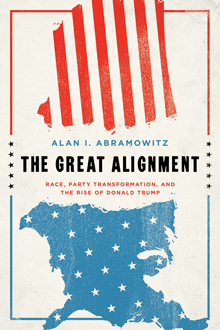When Alan Abramowitz wrote his book "The Disappearing Center" in 2011, he didn't yet realize that political polarization would become the 800-pound gorilla of U.S. politics, smashing so many of the accepted rules and norms.
"The divisions between the parties have gotten much deeper — there's a deeper racial divide, a deeper cultural divide and a deeper geographical divide," says Abramowitz, Alben W. Barkley Professor of Political Science at Emory University.
As long as there have been politics, there have been political divisions. But the political climate that produced a Donald Trump presidency represents a dramatic shift for U.S. politics, Abramowitz writes in his new book, "The Great Alignment: Race, Party Transformation, and the Rise of Donald Trump."
"These divisions are not new, but they've been taken to a new level," Abramowitz says.
 The cracks form
The cracks form
The political divisions of today first began to take shape in the 1960s and 1970s as America experienced a seismic shift in culture and race relations.
In those days, the Democratic Party base included the unionized, working class people in the North and white Southerners. But as American society changed rapidly (thanks in large part to gains in the civil rights and women's rights movements), parties have arranged themselves in a very different configuration as those who resent the changes have become increasingly Republican and those who benefit from and approve of the changes have become increasingly Democratic, Abramowitz says.
In recent decades, surges in immigration from Latin America and Asia and higher birthrates among the nation's younger nonwhite population have created an America that is much less white, Abramowitz says, creating anxiety among many older white voters.
Meanwhile, college-educated Americans are settling down in major metropolitan areas and becoming increasingly secular and open to diversity (race, sexual orientation, nationality), while less-educated people more frequently live and work in less urban areas with more homogenous and religious populations.
None of these changes alone are responsible for the current extreme political polarization, but combined, these shifts in how Americans perceive race, culture and ideology have created the widening gulf between Democrats and Republicans, Abramowitz says.
"We're in a new era of electoral competition in the United States that's a direct result of this transformation of the party system that's occurred over the past 60 years," he says.
The rise of Donald Trump
Political parties which more closely reflect racial and cultural differences have bred intense negative partisanship (strong dislike of the opposing party rather than support for one's own party), according to Abramowitz, and contributed significantly to Hilary Clinton's loss to Donald Trump.
"I see Trump's election as a clear result of this realignment – race, culture and ideology segmented by political party," Abramowitz says. "Negative partisanship in particular was key to Trump's victory. He was able to turn Republicans' intense dislike and mistrust of Hilary Clinton to his advantage," he says.
Negative partisanship, in turn, fostered stronger party loyalty (including straight-ticket voting) and more nationalized voting, according to Abramowitz.
Trump capitalized on voter divisions in several ways – none of which were new – but did so in a much more overt way than previous Republican candidates, he argues.
Trump's ability to tap into racial and ethnic anxiety was much more important to his win than economic anxiety. According to Pew Research Center data Abramowitz details in "The Great Alignment," racial attitudes among white voters were the single most significant predictor of support for Trump's performance six months into his presidency, not education level or income level.
President Obama's win also was made possible by growing party polarization, Abramowitz adds, though the party divide wasn't as pronounced in 2008. Polarization generally produces less moderate candidates from both parties – candidates who may have had a harder time winning at a time when candidates needed to attract a significant number of crossover voters from the opposing party and independents.
2018 and 2020
So what could the more intense party polarization mean for upcoming elections?
2018 is likely to be a pretty good year for Democrats (polarization and Trump aside), Abramowitz says, because the party out of power in the White House typically picks up seats in the midterms.
Though it's much too early to talk about which party might win the presidency in 2020, Abramowitz says it's a pretty safe bet that the election will be close.
"I would expect we're going to see similar divisions in 2020. It's going to come down to the same few states as it did in 2016 and 2012," Abramowitz says. "Don't expect things to get better – it's going to be a very, very polarizing election."

